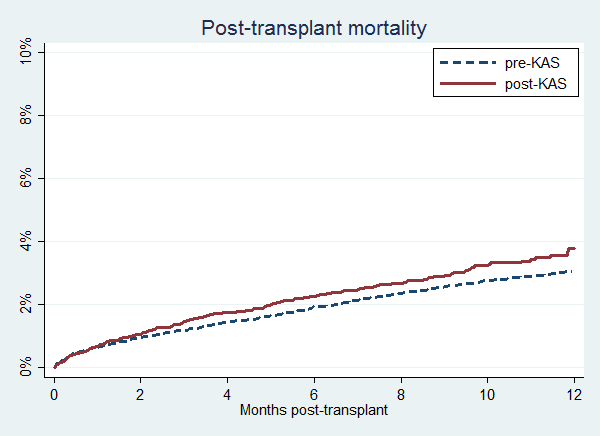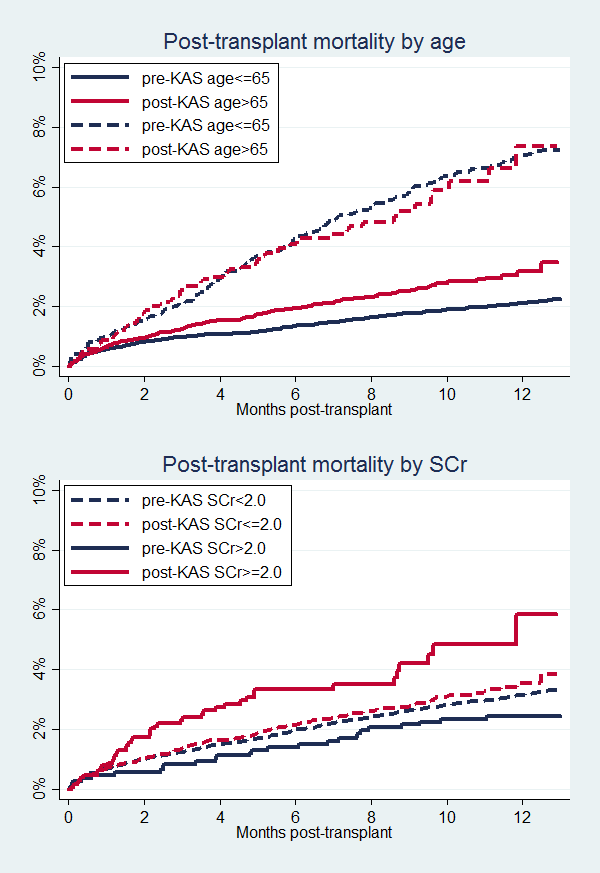Increase in Post-Transplant Mortality Under KAS.
JHU, Baltimore
Meeting: 2017 American Transplant Congress
Abstract number: 117
Keywords: Allocation
Session Information
Session Name: Concurrent Session: Kidney Allocation: Changes and Consequences
Session Type: Concurrent Session
Date: Sunday, April 30, 2017
Session Time: 4:30pm-6:00pm
 Presentation Time: 4:30pm-4:42pm
Presentation Time: 4:30pm-4:42pm
Location: E450a
Following implementation of the Kidney Allocation System (KAS), a major change to deceased donor kidney allocation in December 2014, transplantation rates increased for African-Americans and highly sensitized patients while decreasing for older adults. Changes in post-transplant mortality risk have not been described.
METHODS: Using SRTR data, we compared post-transplant mortality among recipients 12/4/2013-12/3/2014 ("pre-KAS") versus recipients 12/4/2014-12/31/2015 ("post-KAS") using Cox regression.
RESULTS: Overall risk of post-transplant mortality increased by 19% in the post-KAS era (HR=1.01 1.19 1.40, p=0.04, Figure 1). This increase persisted after adjusting for donor, recipient, and transplant factors as measured by the OPTN (aHR=1.01 1.20 1.43), and after adjusting for center-level differences in outcomes (HR with center-level shared frailty = 1.01 1.19 1.40, p=0.04). The association even persistent after excluding recipients with CPRA 99-100 (HR=1.02 1.21 1.44). The KAS-associated change in post-transplant mortality was amplified among recipients age <65 (HR=1.20 1.47 1.81); there was no change in post-transplant mortality among recipients age 65 or older (HR=0.71 0.94 1.24, interaction p<0.01; Figure 2, top panel). The association between KAS and mortality was amplified among recipients of kidneys from donors with terminal serum creatinine>2.0 (HR=1.34 2.20 3.61, interaction p<0.01; Figure 2, bottom panel).
CONCLUSIONS: Post-transplant mortality increased following implementation of KAS for patients under age 65, particularly for recipients of kidneys with serum creatinine above 2.0. The increase in post-transplant mortality under KAS may be mediated by factors not measured by the OPTN. This worrying mortality increase merits careful monitoring and further investigation to understand the underlying cause.

CITATION INFORMATION: Massie A, Garonzik-Wang J, Segev D. Increase in Post-Transplant Mortality Under KAS. Am J Transplant. 2017;17 (suppl 3).
To cite this abstract in AMA style:
Massie A, Garonzik-Wang J, Segev D. Increase in Post-Transplant Mortality Under KAS. [abstract]. Am J Transplant. 2017; 17 (suppl 3). https://atcmeetingabstracts.com/abstract/increase-in-post-transplant-mortality-under-kas/. Accessed December 29, 2025.« Back to 2017 American Transplant Congress
